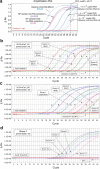Direct RT-qPCR detection of SARS-CoV-2 RNA from patient nasopharyngeal swabs without an RNA extraction step
- PMID: 33006983
- PMCID: PMC7556528
- DOI: 10.1371/journal.pbio.3000896
Direct RT-qPCR detection of SARS-CoV-2 RNA from patient nasopharyngeal swabs without an RNA extraction step
Abstract
The ongoing COVID-19 pandemic has created an unprecedented need for rapid diagnostic testing. The World Health Organization (WHO) recommends a standard assay that includes an RNA extraction step from a nasopharyngeal (NP) swab followed by reverse transcription-quantitative polymerase chain reaction (RT-qPCR) to detect the purified SARS-CoV-2 RNA. The current global shortage of RNA extraction kits has caused a severe bottleneck to COVID-19 testing. The goal of this study was to determine whether SARS-CoV-2 RNA could be detected from NP samples via a direct RT-qPCR assay that omits the RNA extraction step altogether. The direct RT-qPCR approach correctly identified 92% of a reference set of blinded NP samples (n = 155) demonstrated to be positive for SARS-CoV-2 RNA by traditional clinical diagnostic RT-qPCR that included an RNA extraction. Importantly, the direct method had sufficient sensitivity to reliably detect those patients with viral loads that correlate with the presence of infectious virus. Thus, this strategy has the potential to ease supply choke points to substantially expand COVID-19 testing and screening capacity and should be applicable throughout the world.
Conflict of interest statement
I have read the journal's policy and the authors of this manuscript have no competing interests. While DJS was employed at IXIS LLC at the time of this study, his employment there did not create a competing interest. Further, IXIS LLC had no involvement in this study.
Figures



Update of
-
DIRECT RT-qPCR DETECTION OF SARS-CoV-2 RNA FROM PATIENT NASOPHARYNGEAL SWABS WITHOUT AN RNA EXTRACTION STEP.bioRxiv [Preprint]. 2020 Apr 6:2020.03.20.001008. doi: 10.1101/2020.03.20.001008. bioRxiv. 2020. Update in: PLoS Biol. 2020 Oct 2;18(10):e3000896. doi: 10.1371/journal.pbio.3000896. PMID: 32511328 Free PMC article. Updated. Preprint.
Similar articles
-
Detection of SARS-CoV-2 RNA by multiplex RT-qPCR.PLoS Biol. 2020 Oct 7;18(10):e3000867. doi: 10.1371/journal.pbio.3000867. eCollection 2020 Oct. PLoS Biol. 2020. PMID: 33027248 Free PMC article.
-
Automated SARS-COV-2 RNA extraction from patient nasopharyngeal samples using a modified DNA extraction kit for high throughput testing.Ann Saudi Med. 2020 Sep-Oct;40(5):373-381. doi: 10.5144/0256-4947.2020.373. Epub 2020 Oct 1. Ann Saudi Med. 2020. PMID: 32954791 Free PMC article.
-
Detection of SARS-CoV-2 RNA by direct RT-qPCR on nasopharyngeal specimens without extraction of viral RNA.PLoS One. 2020 Jul 24;15(7):e0236564. doi: 10.1371/journal.pone.0236564. eCollection 2020. PLoS One. 2020. PMID: 32706827 Free PMC article.
-
Can quantitative RT-PCR for SARS-CoV-2 help in better management of patients and control of coronavirus disease 2019 pandemic.Indian J Med Microbiol. 2020 Jul-Dec;38(3 & 4):284-287. doi: 10.4103/ijmm.IJMM_20_380. Indian J Med Microbiol. 2020. PMID: 33154236 Free PMC article. Review.
-
Detection of COVID-19: A review of the current literature and future perspectives.Biosens Bioelectron. 2020 Oct 15;166:112455. doi: 10.1016/j.bios.2020.112455. Epub 2020 Jul 21. Biosens Bioelectron. 2020. PMID: 32739797 Free PMC article. Review.
Cited by
-
A Protocol for Simple, Rapid, and Direct Detection of SARS-CoV-2 from clinical samples, using Reverse Transcribed Loop-Mediated Isothermal Amplification (RT-LAMP).Bio Protoc. 2020 Oct 20;10(20):e3789. doi: 10.21769/BioProtoc.3789. eCollection 2020 Oct 20. Bio Protoc. 2020. PMID: 33659444 Free PMC article.
-
Development and Validation of a Novel COVID-19 nsp8 One-Tube RT-LAMP-CRISPR Assay for SARS-CoV-2 Diagnosis.Microbiol Spectr. 2022 Dec 21;10(6):e0196222. doi: 10.1128/spectrum.01962-22. Epub 2022 Nov 29. Microbiol Spectr. 2022. PMID: 36445095 Free PMC article.
-
Optimization of extraction-free protocols for SARS-CoV-2 detection using a commercial rRT-PCR assay.Sci Rep. 2023 Nov 21;13(1):20364. doi: 10.1038/s41598-023-47645-0. Sci Rep. 2023. PMID: 37990045 Free PMC article.
-
Evaluation of Three Automated Extraction Systems for the Detection of SARS-CoV-2 from Clinical Respiratory Specimens.Life (Basel). 2022 Jan 4;12(1):68. doi: 10.3390/life12010068. Life (Basel). 2022. PMID: 35054463 Free PMC article.
-
Different Respiratory Samples for COVID-19 Detection by Standard and Direct Quantitative RT-PCR: A Literature Review.Iran J Pharm Res. 2021 Summer;20(3):285-299. doi: 10.22037/ijpr.2021.115458.15383. Iran J Pharm Res. 2021. PMID: 34903989 Free PMC article. Review.
References
-
- Centers for Disease Control and Prevention Division of Viral Diseases. CDC 2019-Novel Coronavirus (2019-nCoV) Real-Time RT-PCR Diagnostic Panel. Atlanta: Centers for Disease Control and Prevention; 2020.
-
- Nelson AC, Auch B, Schomaker M, Gohl DM, Grady P, Johnson D, et al. Analytical validation of a COVID-19 qRT-PCR detection assay using a 384-well format and three extraction methods. bioRxiv. 2020. April 5 10.1101/2020.04.02.022186 - DOI
Publication types
MeSH terms
Substances
Grants and funding
LinkOut - more resources
Full Text Sources
Other Literature Sources
Medical
Miscellaneous

